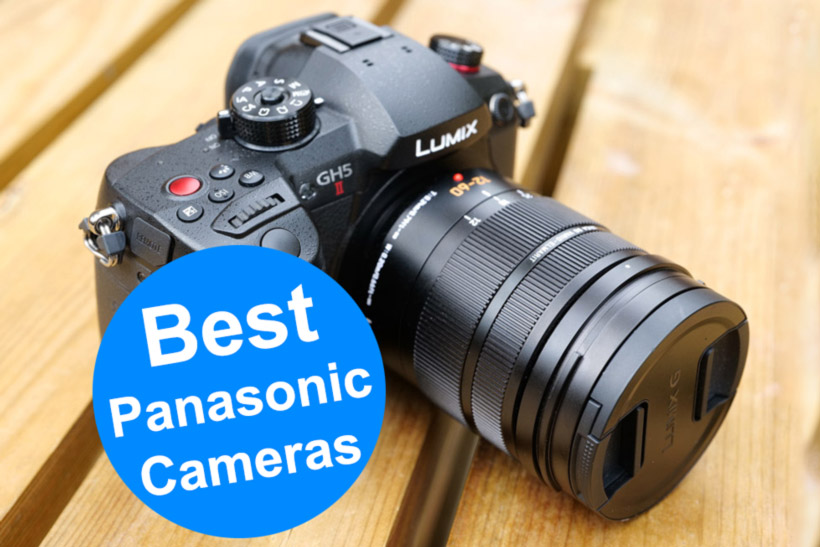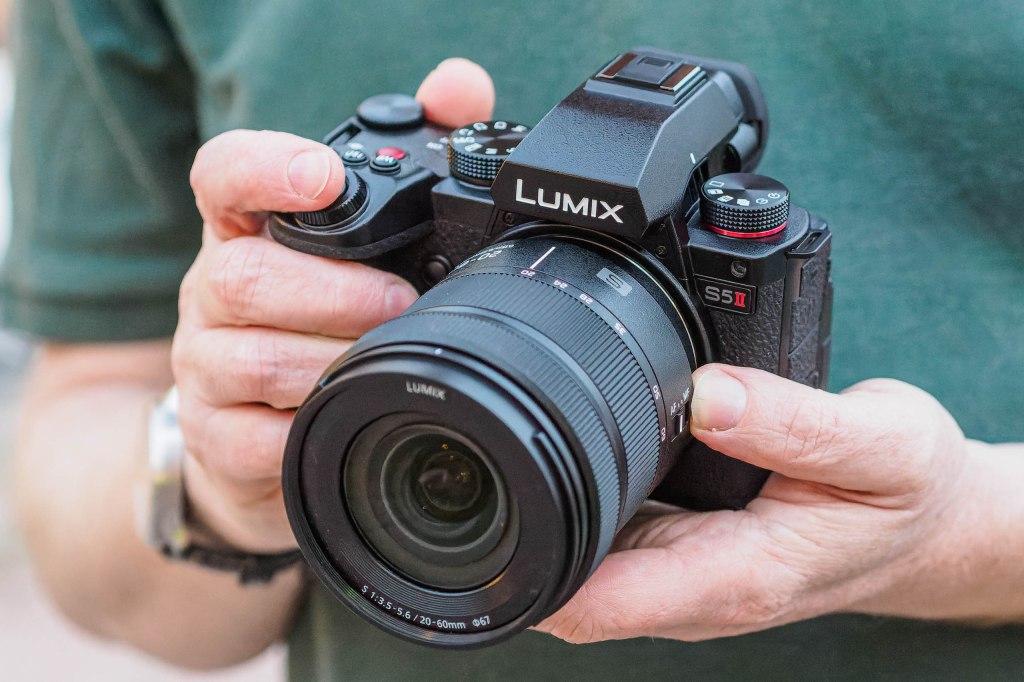Panasonic may be more associated with video features these days, but it remains a powerful force in stills photography. Here are the best Panasonic cameras you can buy this year – whether that’s Micro Four Thirds, full-frame or compact.
Panasonic was actually the first manufacturer out of the gate to commercially release a mirrorless camera – the Lumix G1, in 2008, so it is forever assured a place in the history books. This camera used the Micro Four Third lens mount that Lumix G cameras still use today, though of course, plenty more has changed since then.
Panasonic has built up a reputation for producing mirrorless cameras and compacts that excel at shooting both stills and video. With its Lumix GH series, it has quietly gone about the business of producing some of the best consumer video cameras on the market, while its TZ (ZS) compacts in the US are hugely popular for travel photography.
In 2019, Panasonic opened up a new chapter in its story by taking the wraps off a new mirrorless range. The Lumix S series of cameras boast full-frame sensors, and are part of the L-mount alliance with Sigma and Leica, meaning there’s an enviable selection of lenses to choose from.
We’ve assembled all the best Panasonic cameras (Micro Four Thirds, full-frame and compact) in this guide, so if you’re considering investing in one, read on for a full rundown of the range.
In addition, Panasonic recently announced the Lumix S5 II – see our full review here. The headline improvement is the inclusion of phase detection AF, something that was lacking on earlier models. The S5, for example, only featured Panasonic’s proprietary Depth from Defocus (DFD) autofocus system, which lagged behind the company’s competitors when it comes to continuous AF performance, or ensuring smooth focus transitions when recording video.
This represents a big leap forward for Panasonic users, and should enable the company to compete more effectively with mirrorless rivals like Canon, Nikon and Sony, especially as advanced autofocus has become a key selling point for makers in a very crowded market.
Other tweaks include the addition of a cooling fan above the sensor, with vents on either side of the viewfinder housing. Consequently, the new camera can support unlimited video recording times (or at least, limited only by card space or battery power), without needing a bulky fan unit on the back like the Lumix S1H and Lumix GH6. The S5 remains a very likeable camera, however, as you will see below.
How to choose the best Panasonic camera
Before buying a Panasonic camera there are a number of features and functions to consider.
Firstly, what type of camera are you looking for? If it’s one with a smaller sensor, smaller body, smaller lenses and (typically) a smaller price tag, then a Lumix G series mirrorless camera or a premium Lumix compact camera will probably best suit your needs. Panasonic’s mirrorless cameras are part of the Micro Four Thirds system, and will take any of the best Micro Four Thirds lenses, as well as the best Micro Four Thirds zoom lenses.
If you have a larger budget and are more demanding when it comes to image quality, particularly in challenging situations like low light, then a full-frame Lumix S series mirrorless camera might be more your speed. With larger sensors and high-quality lenses, Panasonic’s S series models are generally larger, heavier and more expensive than their G series cousins, pitched towards serious enthusiasts and professionals in both photo and video.
Other things to consider apply across all types of Panasonic camera. ISO is a measure of light sensitivity (with higher ISO models generally working better in low light conditions), while autofocus and continuous shooting speed are important considerations for those looking to photography fast-moving subjects like sport or wildlife.
Another thing to look out for is in-body image stabilisation, or IBIS. Many Panasonic cameras below offer it, and it ensures that you get some measure of motion compensation no matter what lens is attached – a key boon when shooting videos or photos handheld, or when using longer exposures in low light. Some cameras without IBIS still get the benefit of image stabilisation, but it might be digital-based (which results in a forced crop), or dependent on the lens attached.
Contemporary Panasonic cameras shoot 4K video as a matter of course, and also benefit from clever 4K Photo modes that allow you to extract high-quality stills from the footage. Pretty much whichever Panasonic camera you choose, you’re going to get a solid video shooter – however there are some particular models, like the Lumix GH series, that are particularly well-optimised for filmmakers.
If you’re still deciding on the type of camera you want to buy, check out our guide to DSLR vs mirrorless: which is best. But without further ado, here’s our guide to the best Panasonic cameras you can buy.
Best Panasonic camera for video: Panasonic Lumix GH6
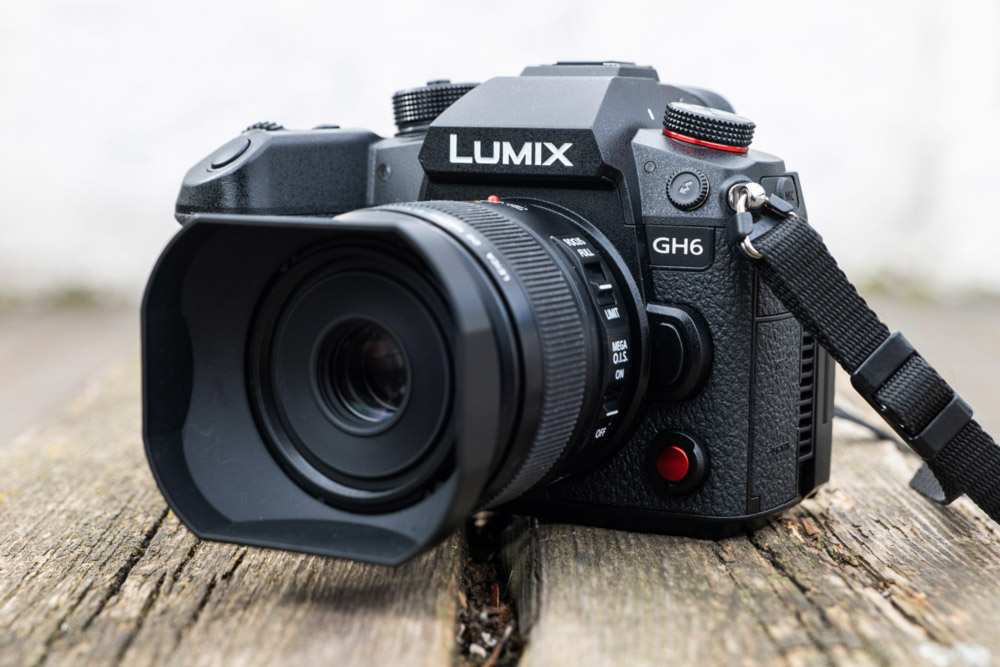
Panasonic Lumix GH6 with lens. Photo credit: Jon Devo
At a glance:
- Micro Four Thirds mirrorless camera
- 25.2MP Live MOS Micro Four Thirds sensor
- 4:2:2 10-bit 4K/60p video recording
- 75fps burst shooting (electronic shutter)
- £1,999 / $1,997 body only
With Panasonic’s S series range of full frame cameras hogging the limelight in recent years, some predicted the company’s Lumix G series, which uses far smaller Micro Four Thirds sensors, would begin to fade away into irrelevance.
The Panasonic Lumix GH6 banishes such notions; this G series flagship is a hugely impressive hybrid that offers professional-level cinema camera features and performance at a price no rival (Panasonic or otherwise) can match. Relatively compact, user-friendly and easy to handle, it’s a hugely powerful creative tool for filmmakers, and solid for still photography too.
The GH6 isn’t perfect, with the retention of Panasonic’s contrast-based Depth From Defocus autofocus system perhaps the most disappointing thing about it. That said, the company has improved AF to the point where it rarely feels like a barrier to getting the shots you want here, and thoughtful design touches like built-in cooling (for unlimited recording time), a full-size HDMI output and a highly flexible rear touchscreen make the GH6 a joy to use.
Pros:
- Pro video from a compact body
- Huge range of video codecs
- Superb 5-axis IBIS
- No recording time limits
Cons:
- Sticks with Depth From Defocus AF system
- No internal RAW recording
- No 6K/4K Photo mode
Read our Panasonic Lumix GH6 review
Best Panasonic camera for vloggers: Panasonic Lumix GH5 II
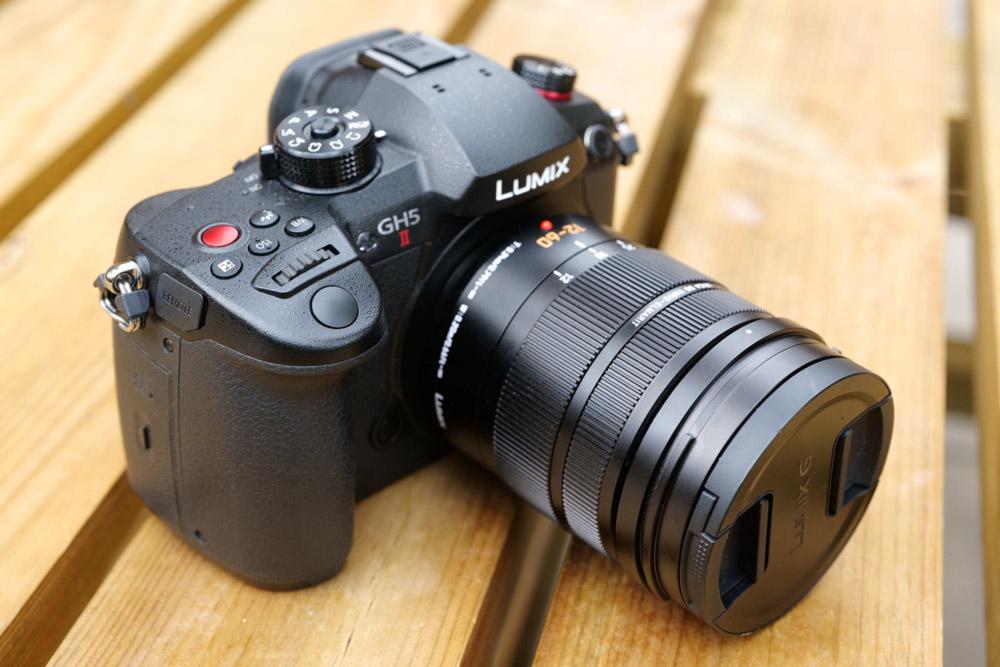
Panasonic Lumix GH5 II with 12-60mm lens. Photo credit: Jon Devo
At a glance:
- Micro Four Thirds mirrorless camera
- 20.3 Live MOS Micro Four Thirds sensor
- 4:2:0 10-bit 4K/60p video recording
- Wireless and wired live streaming
- £1,499 / $1,497 body only
The long-awaited follow-up to the beloved GH5, the Panasonic Lumix GH5 II is, like its predecessor, a flexible all-rounder with plenty for both videographers and photographers to like. It leans more to the video side, with its wide range of codecs, frame rates, resolutions and more to choose from making it a pro-level choice – even if the launch of the GH6 a few months later has taken the shine off somewhat. We think most filmmakers would be better off spending a little extra to get the more powerful GH6, but beyond the obvious greater affordability the GH5 II does have a couple of advantages over its big brother: it supports video live streaming and it’s around 100g lighter.
That makes it a good choice as a vlogging camera (its 6.5-stop 5-axis IBIS, full-size HDMI, vari-angle screen and ability to run via USB-C power delivery are appealing in this regard too), and content creators will also welcome its photography skills (including 6K/4K Photo) when making thumbnails and other still images.
If the GH5 II has weaknesses, it’s that it uses a contrast-detection autofocus system rather than a more advanced hybrid setup (not a deal-breaker by any means) and that its limited ISO range means it’s not a fantastic performer in low light conditions.
Pros:
- Pro video features
- Full-size HDMI output
- Can be powered by USB-C
- Live streaming capabilities
Cons:
- Limited ISO sensitivity
- Outdated AF system
Read our Panasonic Lumix GH5 II review
Best entry-level Panasonic mirrorless camera: Panasonic Lumix G100
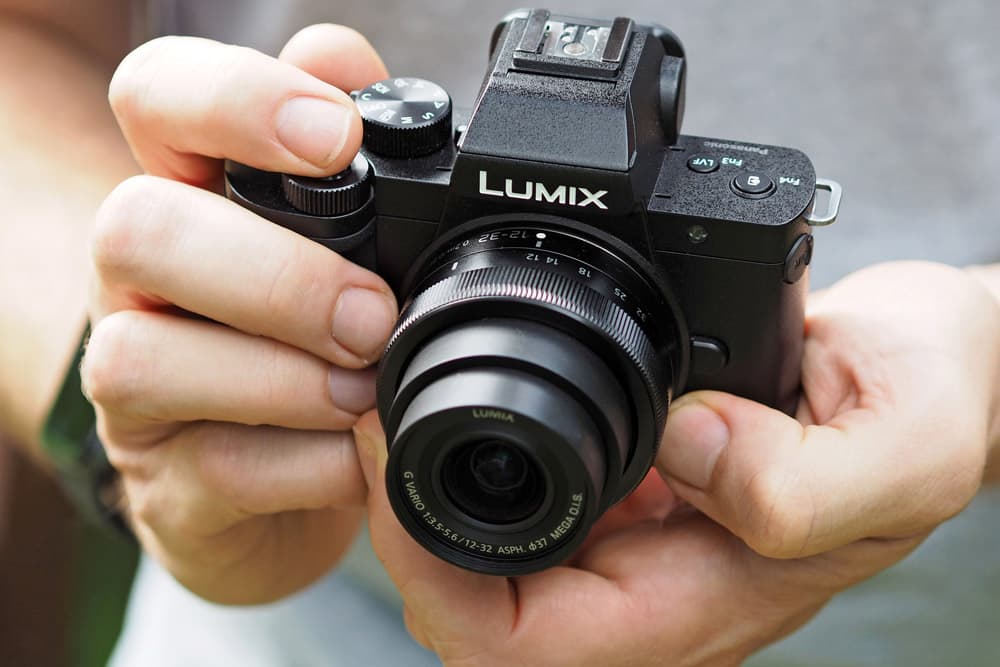
Panasonic Lumix G100 in hand. Photo credit: Richard Sibley
At a glance:
- Micro Four Thirds mirrorless camera
- 20.3MP CMOS Micro Four Thirds sensor
- 4K video at up to 30fps
- ISO 200-25,600 (expandable to ISO 100-25,600)
- £399 body only, £569 / $597 with 12-32mm lens
The Panasonic Lumix G100 is currently the cheapest mirrorless model in the company’s entire range, aimed chiefly at younger photographers and vloggers upgrading from smartphones into dedicated camera gear. It’s small and lightweight (just 345g without a lens) but still finds room to include an electronic viewfinder which, with a 3.68m-dot equivalent resolution, is truly impressive in a camera at this price point.
Despite its small size, we found the G100 easy to handle and use, with a large grip on the front and thumb rest at the rear. Buttons and dials are thoughtfully located, while the rear screen can be tilted and flipped to face forward, making the camera ideal for vlogging and selfies.
The G100 can record 4K footage at up to 30fps, and stabilise it too – although it does this electronically rather than optically, and that results in a severe 1.8x crop when shooting 4K. 4K clips are also limited to 10 minutes in length, but if you can work around these limits you’ll find this to be a solid all-rounder at a really competitive price.
Pros:
- Excellent value for money
- Solid vlogging features
- Good handling for its small size
- Impressive viewfinder
Cons:
- Heavy crop with electronic stabilisation
- 4K clips limited to 10 minutes
Read our Panasonic Lumix G100 review
Best mid-range Panasonic mirrorless camera: Panasonic Lumix G90 / G95
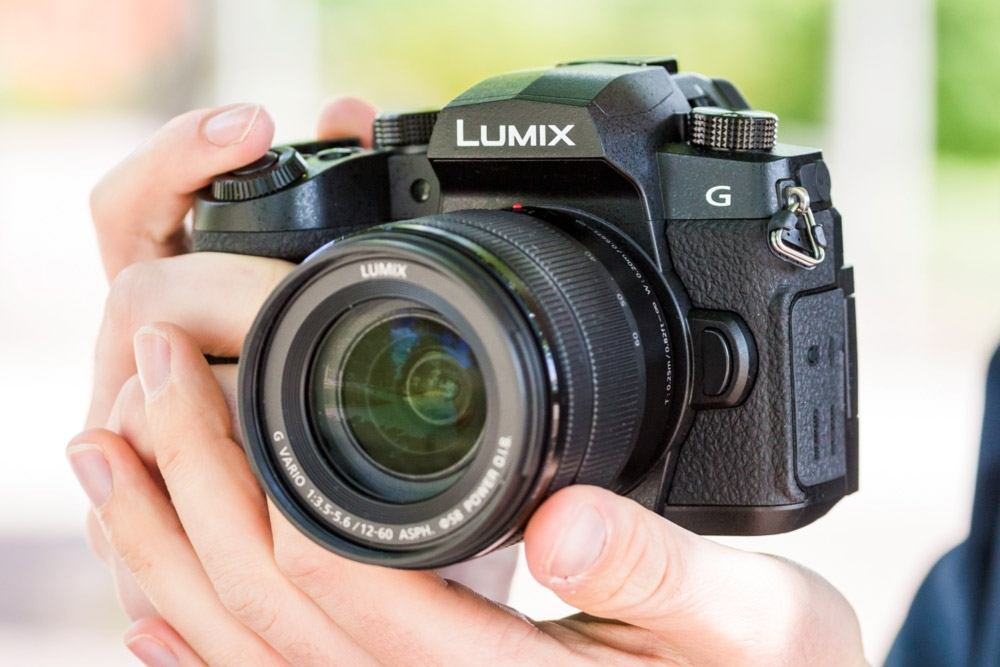
Panasonic Lumix G90 with 12-60mm lens in hand. Photo credit: Michael Topham
At a glance:
- Micro Four Thirds mirrorless camera
- 20.3MP Live MOS Micro Four Thirds sensor
- 4K video at up to 30fps
- In-body image stabilisation
- Around £599 / $539 used (body-only)
A slightly scaled-down version of the premium, stills-focused G9, the Panasonic Lumix G90 is a mid-range Micro Four Thirds model that delivers solid performance across both photo and video. It’s a rugged, weather-proof camera with a DSLR-style shape and comfy handling, and features include IBIS that adds up to 5 stops of compensation when shooting handheld, whether the lens you’re using has its own stabilisation or not.
Able to record 4K video at up to 30fps (and output 8-bit 4:2:2 video to an external recorder via micro HDMI) and equipped with a touchscreen that can be flipped and twisted to face fully forwards, it’s clear that the G90 has been made with vloggers in mind, while shifting resolution down to Full HD allows for 120fps recording and slow motion playback. Image quality is solid across the board.
Note: at the time of writing new G90s appear to be in very limited supply, suggesting it’s about to be discontinued. It’s still available used or refurbished, of course – but do bear in mind that’s it’s one of the older models here if you’re considering purchasing one.
Pros:
- Effective IBIS
- Weather-sealed construction
- Comfortable DSLR-style handling
Cons:
- EVF less sharp than G100
- Plastic body
Read our Panasonic Lumix G90 review
Best rangefinder-style Panasonic mirrorless camera: Panasonic Lumix GX9
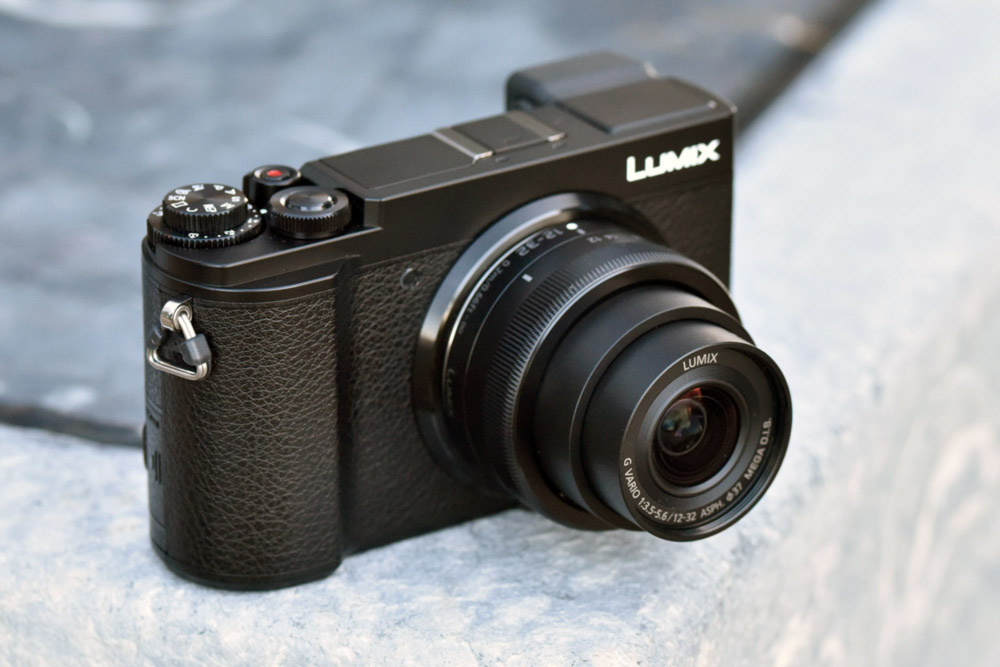
Panasonic Lumix GX9 with 12-32mm lens. Photo credit: Andy Westlake
At a glance:
- Micro Four Thirds mirrorless camera
- 20.3MP Live MOS Micro Four Thirds sensor
- 4K video at up to 30fps
- In-body image stabilisation
- £549 with 12-32mm lens; $797 with 12-60mm lens
While most of Panasonic’s mirrorless models get their design cues from DSLRs, the company also does a small line of rangefinder-style camera bodies. The Panasonic Lumix GX9 is one of these, with a flatter, slimmer profile, no large hand grip and no central ‘bump’ to house its EVF and hot shoe. Instead there’s a tiny bump for the user’s right hand to wrap around and the hot shoe and viewfinder are incorporated right into the main body. The viewfinder and screen do tilt, though, giving them a welcome extra measure of flexibility, and there’s room for IBIS, which is impressive in such a compact body. The small size and quiet operation makes this a good model for street photography.
The cramped design does cause some handling issues and the default control layout is awkward and poorly thought-out. Users can customise controls to ameliorate this somewhat, but Panasonic should be doing better. The 16:9 ratio viewfinder is another odd touch; it suits video shooting well, but wastes lots of space when it comes to still photography.
Pros:
- Compact, portable design
- Effective IBIS
- Quiet shutter allows discreet shooting
Cons:
- Awkward default controls with EVF shooting
- 16:9 viewfinder doesn’t match sensor well
- Not weather-sealed
Read our Panasonic Lumix GX9 review
Best entry-level Panasonic travel zoom: Panasonic Lumix TZ100 / ZS100
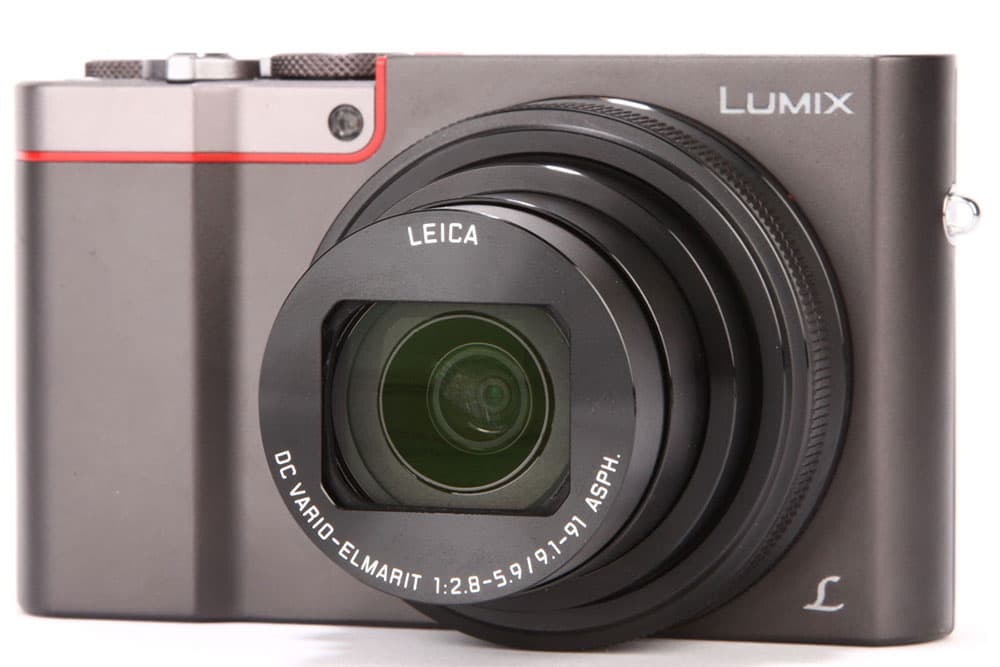
The Panasonic Lumix TZ100 up close. Photo credit: AP
At a glance:
- Compact camera with 1-inch 20.1MP sensor
- 25-250mm equivalent f/2.8-5.9 Leica DC lens
- ISO 80-25,600 (extended)
- 4K 30p video
- £429 / $497
Deservedly, the Panasonic Lumix TZ cameras (or Lumix ZS if you’re in the US) are some of the most popular travel zooms around. While the Lumix TZ100 is not the biggest, flashiest or newest, we reckon its combination of intuitive controls, a big zoom range, a pocketable body and a friendly price tag (even more so since release) make it the best choice for most users.
Covering a huge zoom range from a wide 25mm to a considerably telephoto 250mm, the Lumix TZ100 can shoot pretty much anything. What’s more, its 1-inch sensor (an upgrade from previous TZ cameras) means you’ll notice a tangible difference in image quality compared to your smartphone. Just be aware that the lens aperture of f/2.8-5.9 is pretty modest, meaning you might sometimes struggle to get sharp shots when the light goes low. Though the Hybrid 5-axis optical/electronic image stabilisation does help somewhat in this department, as we noted in our full review of the camera back when it was released.
The future of compact cameras is uncertain, and we may not get many – or any – more TZ cameras after the latest TZ200, which adds a longer zoom than the TZ100, at the cost of an even narrower maximum aperture. Still, as long as the Lumix TZ100 is still available, new or used, we’ll keep recommending it to anyone who’s looking for a well-made travel zoom camera.
Pros:
- Impressive zoom range covers everything
- Good 1-inch sensor quality
- Generous ISO range
- Slim, pocketable body
Cons:
- Narrow max aperture
Read our Panasonic Lumix TZ100 / ZS100 review
Best full-frame Panasonic camera: Panasonic Lumix S5

Panasonic Lumix S5, a 24MP full-frame camera. Photo credit: Michael Topham
At a glance:
- L Mount mirrorless camera
- 24.2MP full-frame CMOS sensor
- ISO 100-51,200 (expandable to 50-204,800)
- 4K video at up to 60fps
- £1,599 / $1,697 body only
Panasonic is still a relative newcomer to the full-frame game, with its L Mount range only arriving in 2019. Of the handful of L Mount cameras we’ve reviewed thus far, the Panasonic Lumix S5 has the most overall appeal, and that’s mostly down to its relatively compact, lightweight size and excellent DSLR-style handling, which comes without a significant impact on performance or features. In fact, autofocus feels snappier here than on the S1 and S1R, despite the general image quality being on a par with the (much larger) S1.
The S5 comes with IBIS to stabilise any attached lens, a rugged and weather-sealed magnesium alloy build and a wide range of options for videographers including HDR, V-Log and S&Q (slow and quick) recording, RAW output and the ability to use anamorphic lenses and (with Panasonic’s adapter) pro-level microphones. That you get all this in a body that’s compact and lightweight feels like the S5 is Panasonic properly finding its full-frame feet – and hopefully a taste of even better things to come in the range. As mentioned above, Panasonic recently announced the S5 II, featuring phase detection AF – full review to follow.
Pros:
- Smallest, lightest Panasonic full-frame camera
- Excellent handling and controls
- Rugged, weather-proof body
- Wide range of video options
Cons:
- Only one high-speed card slot
- Some controls feel plasticky
Read our Panasonic Lumix S5 review
Best full-frame Panasonic camera for stills photography: Panasonic Lumix S1R

Panasonic Lumix S1R. Photo credit: Michael Topham
At a glance:
- L Mount mirrorless camera
- 47.3MP full-frame CMOS sensor
- ISO 100-25,600 (expandable to 50-51,200)
- 4K video at up to 60fps
- £2,799 / $3,697 body only
Along with the S1, the Panasonic Lumix S1R was the vanguard of Panasonic’s 2019 arrival in the full-frame mirrorless market. A few years on, this large and bulky camera (which offers almost no size or weight advantage over a full-frame DSLR) is less likeable than the newer, cheaper, more compact S5, but it does have one major advantage: its high-resolution sensor, with a pixel count of 8368 x 5584. This of course captures beautifully sharp images at its 47.3MP native resolution, but via clever stitching can also create truly stunning 187MP shots. The S1R is less video-centric than either the S5 or S1, but can record 4K at up to 60fps too.
In terms of design it’s every bit the premium enthusiast’s camera it sets out to be. The body is rugged and weather-sealed and the 5.76-million dot electronic viewfinder may well be the sharpest and punchiest of any current camera on the market. The IBIS is effective; the autofocus less so, feeling particularly hesitant in low light.
Pros:
- Amazingly detailed images
- Superb electronic viewfinder
- Effective IBIS
- Rugged, pro-level build quality
Cons:
- As large and heavy as a full-frame DSLR
- Slow autofocus in poor lighting
Read our Panasonic Lumix S1R review
Best full-frame Panasonic camera to buy second-hand: Panasonic Lumix S1
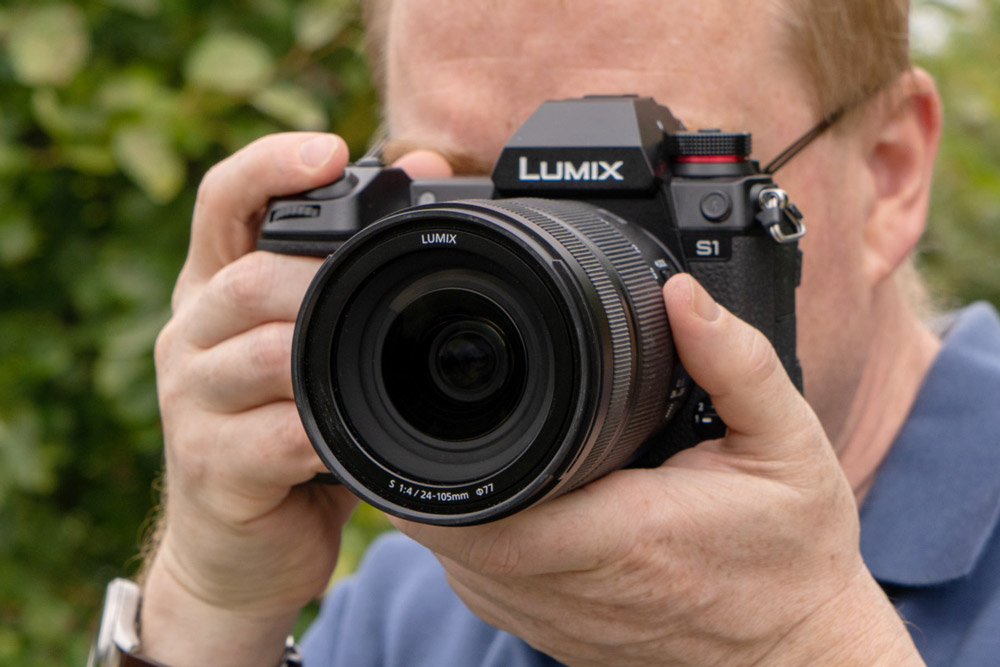
Panasonic Lumix S1 in hand. Photo credit: Andy Westlake
At a glance:
- L Mount mirrorless camera
- 24.2MP full-frame CMOS sensor
- ISO 100-51,200 (expandable to 50-204,800)
- 4K video at up to 60fps
- £1,999 / $2,497 body only
The Panasonic Lumix S1 was one of the first full-frame cameras made by the company, and the arrival of the S5 has seen its appeal fade. That’s not to say this isn’t an impressive camera in its own way, benefitting from a healthy selection of video shooting options, impressive 5-axis IBIS, rock-solid (and weatherproof) build quality and thoughtful position of its controls, which puts everything important at your fingertips.
It does have some slight advantages over the S5 too, in the form of faster continuous shooting and a sharper, clearer EVF. Now that it’s available at a cheaper price than launch and widely available used, that does make it a potentially tempting buy over the S5 – if only in certain circumstances.
The S1’s heft and size are an issue, though: with a premium lens attached it’s just as large and heavy as a full-frame DSLR, which immediately eliminates one of the main advantages of choosing a mirrorless full-frame camera.
Pros:
- Superb EVF
- IBIS
- Rugged build
- Thoughtful control layout
Cons:
- Large and heavy
- AF faster on cheaper S5
Read our Panasonic Lumix S1 review
Best overall Panasonic camera to buy second-hand: Panasonic Lumix GH5
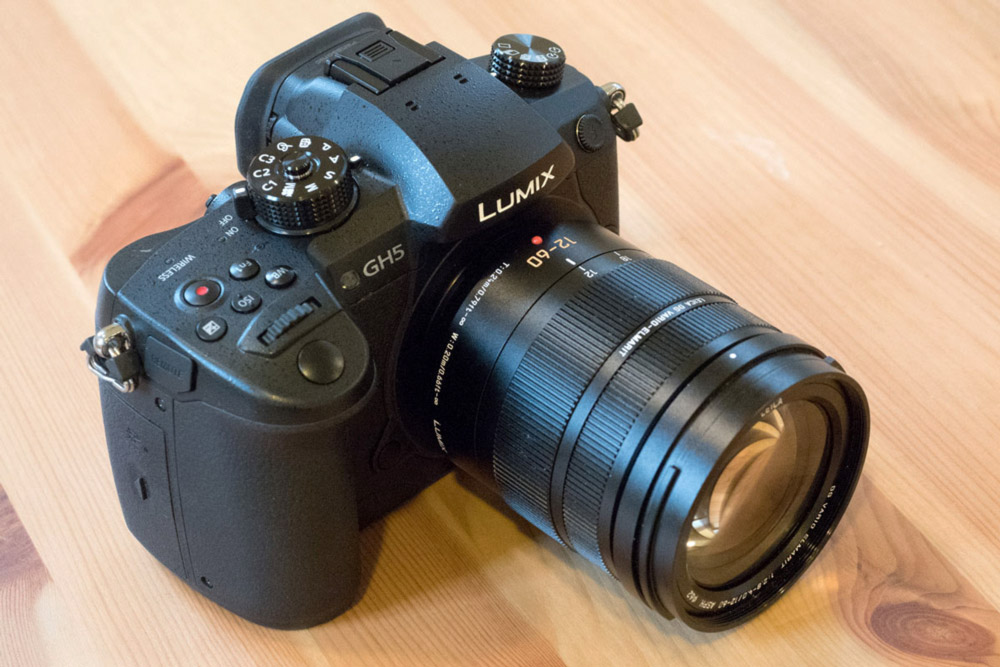
Panasonic Lumix GH5 with lens. Photo credit: Andy Westlake
At a glance:
- Micro Four Thirds mirrorless camera
- 20.3MP Live MOS Micro Four Thirds sensor
- ISO 100-25,600 (extended)
- 10-bit 4:2:2 4K video recording
- £1,299 / $1,297 body only
When it comes to video-focused Lumix G series cameras, the Panasonic Lumix GH5 has now been superseded by both the GH5 II and the GH6. Panasonic has retained it as a current range model, however, and while we don’t think you should buy it brand-new over either of the aforementioned models, its age and popularity make it readily available and affordable as a second-hand purchase.
The GH5 is something of a modern classic, prized for being one of the first small mirrorless cameras to deliver a professional 4K video recording experience alongside strong still photography performance. With IBIS and a clear, detailed EVF on board, as well as excellent handling and a user-friendly control layout, it remains an impressive hybrid model today, particularly for multi-disciplinary content creators who want to dabble in both movies and photos without major compromise. If you can pick it up cheaply used or refurbished, it’s a fantastic camera with bags of creative potential.
Pros:
- Video performance still impressive today
- Superb handling and control layout
- Clear viewfinder
- 5-axis IBIS
Cons:
- Noisy images at high ISO
- Heavy by Lumix G standards
- GH5 II and GH6 now better for video
Read our Panasonic Lumix GH5 review
Best Panasonic premium compact camera: Panasonic Lumix LX100 II

The Panasonic Lumix LX100 II premium compact. Photo credit: Andy Westlake
At a glance:
- Compact camera with 17MP Four Thirds MOS sensor
- 24-75mm f/1.7-2.8 lens
- ISO 100-25,600 (extended)
- 4K video at up to 30fps
- £799 / $797
Despite being several years old, the Panasonic Lumix LX100 II remains a fantastic premium compact that puts mirrorless-level performance in a lightweight and affordable fixed zoom lens device. Compact enough to fit in a jacket pocket and just 393g, it has a large sensor and wide maximum aperture of f/1.7-2.8 (depending on your focal length) allowing it to keep shutter speeds fast and low light performance impressive.
Its standard zoom range can handle most types of shot you might want to take, making this a fine choice if you’re travelling and want to keep things neat and tidy rather than cart about a body and several lenses. It can also record 4K video (with a slight crop), but the unarticulated screen does restrict its use as a vlogging tool.
The LX100 II was released in 2018, making it high time for Panasonic to unveil a replacement. Until it does, this remains the company’s most desirable compact camera, and one that you should be able to find fairly easily used or refurbished for even less than its MSRP.
Pros:
- Large sensor in a compact body
- Versatile, fast lens
- Engaging manual controls
Cons:
- Unarticulated screen
- Lens prone to flare when shooting into sun
Read our Panasonic Lumix LX100 II review
If you’re going for a Micro Four Thirds camera, make sure you have a look at the best Micro Four Thirds lenses available. For more options, have a look at our latest buying guides, and reviews.

